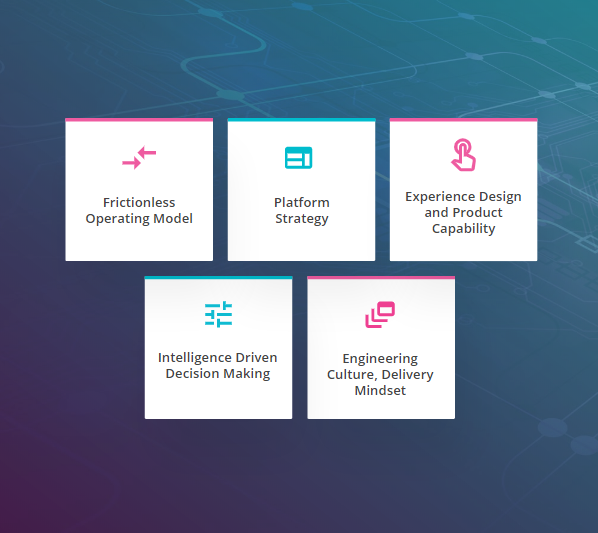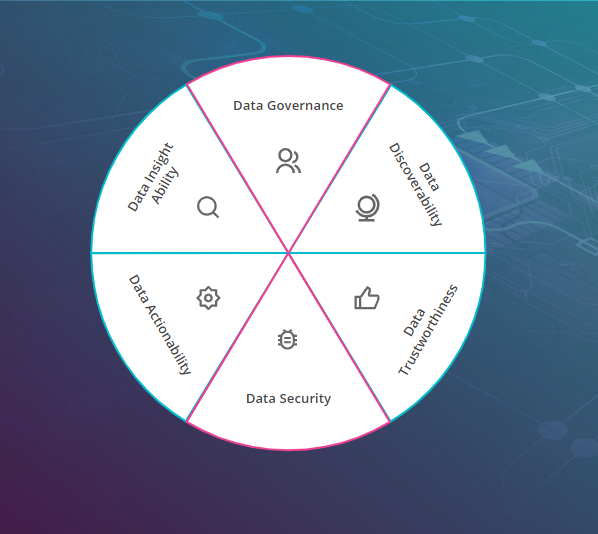A data-guided path to success
Over the past several years, Thoughtworks has been tracking the emergence of a new breed of ultra-successful companies. These are organizations that outmatch the competition through creating deeper customer insights, going to market faster and consistently bringing new, customer-delighting products and services to market. We call these companies Modern Digital Businesses.
These market leaders haven’t emerged by chance. They’ve used their mastery of data to glean vital operational information faster than competitors and to turn into actionable insights before their competitors even knew an opportunity existed.
In this piece, we’ll explore how your organization can become a master of data and how you can use that to build a Modern Digital Business (MDB).
What is an MDB?
We see MDBs as having five fundamental building blocks. These are:
- Intelligence-driven decision making. Decisions are made by your staff, based on information extracted and visualized by computers, or they’re made autonomously by machines, based on their models of the world.
- Frictionless operating model. Business can capitalize on opportunities, respond to competitive threats and scale successful investments by removing friction organizational structures, processes and culture.
- Platform strategy. The best platform strategies ensure enterprises can leverage new digital tools, without losing the advantages of the technologies and processes that came before.
- Experience design and product capability. MDBs have a laser-focus on enhancing the customer experience, and are dedicated to listening to their customers — not just having their own preconceptions about what the customer wants.
- Engineering culture, delivery mindset. MDBs depend upon a thriving engineering culture, with a deep knowledge of software practices and skills to leverage technology to meet business goals.


Data’s role in building an MDB
Each building block of the Modern Digital Business is underpinned by a corporate culture of data excellence: being focused on collection and collation of high-quality data, which is then in turn used to make decisions.
Intelligence-driven decision making
Intelligence-driven decision making is entirely dependent on data. To boost the organization’s operational speed and efficiency, some decisions are entirely automated, through the application of machine learning algorithms. Other decisions, while still made by staff, are informed by the best possible information.
Frictionless operating model
Data is vital to a frictionless operating model. Information and insights are continuously condensed out of actual data and the findings are visualized for business level decision making. Thus, when the data says 'move', a digital organization is able to execute immediately.
Platform strategy
In this paradigm, data is easily accessible and discoverable in business-domain-owned data meshes. The architecture of the data mesh follows a domain-driven design, in which the underlying technology is standardized and cloud-based. Data can be accessed by simple APIs as self-services, meaning users can pull any data they require on demand. Domains offer their data as ‘data products’ with responsible product owners to other domains to ensure that data can easily be digested and combined everywhere in the organization.
Experience design and product capability
Data is the most important raw material for designing digital products. That means your data scientist and product owners need actual and historical data, from different domains, to be easily available and discoverable. By analyzing this data they find new ideas and customer demand for new products, giving insights to real world behaviors, that power continual execution, drive iterative hypothesis testing and iterative value generation. Advanced analytics and machine learning is used to design new digital services and products based on this data.
Engineering culture, delivery mindset
Technical excellence is at the heart of this characteristic. It means all software projects are treated as data projects. Everybody involved in these projects exhibits a certain degree of data literacy. Different roles (like data scientists, data engineers, software developers, operations) are working in mixed teams without walls between them and departments. The software delivery infrastructure like repositories, versioning control, pipelines and orchestration tools are able to handle not only code, but also data and model parameters. Continuous Delivery and Continuous Integration works smoothly for data and machine learning models (see CD4ML article).
Data proficiencies a modern digital business must develop
Data is a central piece in modern digital businesses, and organizations that are masters at using data have developed new skills in how to collect, discover and transform data. There are six fundamental proficiencies organizations have to develop:
- Data governance: the general management of data assets within an organization
- Data discoverability: The ability to access and discover data
- Data trustworthiness: The extent of trust into data and derived information and insights
- Data insight ability: The ability to create insights out of data
- Data actionability: The ability to perform actions based on the insights
- Data security and data protection: The ability to protect your data


Data governance
Modern digital businesses have a high degree of data literacy. It’s essential that everybody in the organization understands the fundamental importance of data. Every project is also a data project, as it produces and consumes data and affects the overall data flow in the organization. Enterprise-wide data governance defines the rights and duties of data providers and data consumers. Every decision in the organization is based on trustworthy data.
Data discoverability
Information needs to be at everyone's fingertips, where it’s very easy to ingest by everybody in the organization (following data accessibility and legal data privacy rules, of course). Information can be accessed by simple and standardized APIs, self-services and freely combined to gain new information and insights.
Data trustworthiness
People in any organization will only allow intelligent and data-driven decisions to be executed if they have trust in their data. Pre-digital organizations introducing data-driven decisions often find that people in the organisation don’t trust the data and the decisions based on them, and overrule the automatic processes by manual decisions. As in human relations, trust comes with understanding and positive experiences. In modern digital businesses, people have great trust in their data and the decisions based on them. They understand the provenance of the data and the way decisions are made. They’re also aware of possible biases in the data. A high data trustworthiness doesn’t necessarily mean that data always has a high quality. Modern mathematical and statistical algorithms can (like humans) deal with incomplete, inconsistent and often noisy data.
Data insight ability
Modern digital businesses have a strong capability to generate information and insights out of data. This is done by data scientists and analysts. They model the data with advanced analytics and machine learning frameworks. Data time series and streams are modeled to predict future events. The derived insights are at the core of every decision and action in the organization.
Data actionability
The best data insights are useless if they don’t lead to actions. Therefore, bringing information and insights into actions in a fast and efficient way is another fundamental proficiency of a modern digital business. Insights are visualized to support business decisions (data storytelling) or included in the software development and operations process by CD4ML.
Data security and protection
As data is becoming the fundamental asset in a modern digital business, it’s important to secure and protect it. The data has to be protected against unauthorized access from inside and outside the organization. It also has to be protected against loss and corruption. More importantly for person-related data digital privacy and the obligations of legal requirements like GDPR (General Data Protection Regulation in Europe) must be secured.
Data is at the core of every Modern Digital Business
Becoming a truly Modern Digital Business isn’t solely an IT project. It’s a cross-organizational effort that affects every aspect of your organization, with technology and business working hand in hand. We’ve identified five building blocks that you have to develop in your organization. We’ve shown that data plays an essential role in each of these building blocks. In order to successfully develop these building blocks, the organization will need six data proficiencies in their IT environment and workforce skills.
Here are some examples of how you can start building these proficiencies in your organization right away:
- Understand the importance of data. Everybody in your organization — starting from the very top to the grassroots — should understand the importance and criticality of data for the business. Data is a raw material for your value creation, it should be available for everybody involved and not owned by single business units or “silos” in your organization.
- Make your data discoverable. Data in ERP systems or relational databases aren’t considered discoverable. They’re fixed in their tabular data schema and hard to extract and wrangle with. Data scientists love data lakes with simply structured or unstructured data, but be aware: setting up huge organization-wide data lakes are mega projects, too big to swallow for most organizations and usually doomed to fail. Multiple smaller, domain-specific data lakes like data meshes, with clear ownership in the domain, offering data per self-services to other domains to build data services and products is the way to go.
- People must have trust in the data. Set up continuous processes and high standards to clean-up and quality-check incoming and generated data. Decisions based on data should be made as transparent as possible and, if employees have doubts, treat them seriously. Find out where these doubts are coming from, look into the data and the decision process (including the speed of the decision process), compare with human decisions and convince people. You can’t simply mandate that automated decisions are trusted. And be aware that bias in your data can have a devastating impact on the decisions made based on these data and therefore on your business and public image.
- Request every decision to be data-driven or at least data-proofed. Don’t accept decisions by gut feeling, opinions or “we did it always like this” any more. Continue on this route and you’ll fail, as those that use data-driven decisions adjust quicker to the changing environment.
- Try to automate decision making as much as possible. Ask your data scientists to model decision making or use RPA (robotic process automation), at least for mundane processes in your organization. Upskill the employees whose daily job was to make these decisions to train and maintain the data models and RPA software or to work on more strategic topics.
- Analyzing and modeling the data and creating information and insights out of it should be a core competency in your organization. Don’t outsource this. It’s a major pillar for creating value out of your data and becoming a data-driven organization with a leading edge. You’ll need data analysts, data scientists and a proper data infrastructure and processes. Make sure their work is transparent, openly available, repeatable and not bound to single heads.
- Pave the way from data insights to operation in your organization. Great data science models and insights are useless if they only reside in Jupyter notebooks. They only create value when they reach the end user. Don’t let your data analytics and data science team work in isolation: set up mixed teams together with data engineers, developers and IT operations. Done means that data is available for the end user. CD4ML helps you to set up processes and an infrastructure to move data science models smoothly, securely and continuously from development to production.
- Last but not least make sure your data is protected: against theft and misuse from inside and outside your organization, and that the proper protection of sensitive and personal data — obeying applicable regulations like GDPR and against catastrophic loss — are in place. Data will become a main ingredient of your business value creation and “the blood”, flowing through your organization and keeping it healthy!
Unfortunately, there is no Holy Grail plan to becoming a modern digital business, nor should there be. It’s a journey that each organisation needs to define and learn as they go. Not every company needs to become the Amazon, Netflix or Google of its industry. Instead, every organization has to find their own authentic digital self.
Thoughtworks has developed the Digital Fluency Online Tool to help organizations to understand where they should be versus where they are. It helps you to identify what are the core capabilities you need to work on to bridge the gap to where you aspire to be.
But remember, this is just a starting point of a complex never ending journey, there’s no such thing as a plan: the ambiguity is constantly challenging us to keep changing to remain digitally fit!















